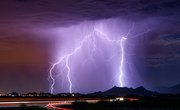
Weather forecasters often talk of several types of fronts influencing the weather. Cold fronts passing through an area mean that people need to brace themselves for the type of weather associated with a cold front, especially colder temperatures. Yet, if you are a student studying weather in schools, understanding cold front characteristics is important in developing your knowledge about how weather changes work.
TL;DR (Too Long; Didn't Read)
A drop in temperature is the most apparent feature of a cold front as it passes through an area, along with changes in air pressure and prevailing winds.
Before the Cold Front
When a cold front is forecast for your area, it means that several things are happening prior to the cold front passing through. The winds will be moving from the south to the southwest, with temperatures at the head of the cold front being warm. As the cold front is monitored, it will be evident that the temperatures between the start of the front to the rear of it change significantly, dropping through increased cloud accumulation. For example, the temperature at the start of the cold front might indicate that it is 75 degrees Fahrenheit, while at the rear of the cold front the temperature is 50 degrees Fahrenheit. The cold front will also contain periodic showers, as well as a high dew point and hazy visibility.
During the Cold Front
As the cold front passes in your area, a sudden drop in temperature will occur, with the winds building and shifting. The rain will increase and may contain a mixture of hail, lightening and thunder. Cumulonimbus clouds are common in a passing cold front, with the large clouds extending high into the sky. The hazy visibility in the cold front will continue, then begin to slowly clear as the front continues to pass by.
Following the Cold Front
Once the cold front passes by your area, the winds will shift to a west-northwest pattern, as the temperatures continue to decline. Rain will continue to fall from primarily flat cumulus clouds, as air pressure rises consistently. While the cold front continues to pass by, the showers will subside and the hazy visibility on the ground will fade to clear.
Other Characteristics
Cold fronts commonly have rapid movement and are connected to severe weather. For example, thunderstorms and squall lines, or multiple thunderstorms, may occur with the presence of a cold front. Additionally, cold fronts have extended weather patterns that may start at one location, such as Canada, and stretch to a location much farther away, such as Oklahoma. However, because of their massive presence on radar and the severe weather activity that cold fronts generate, they are identified more rapidly than other types of fronts by forecasters.
References
Resources
About the Author
Patrice Lesco has been a writer since 2001. Also a certified teacher, she writes for newspapers, magazines, books, theater and film. Lesco holds a Master of Fine Arts in theater from Michigan State University, as well as a Bachelor of Science in education and theater from Methodist College.
